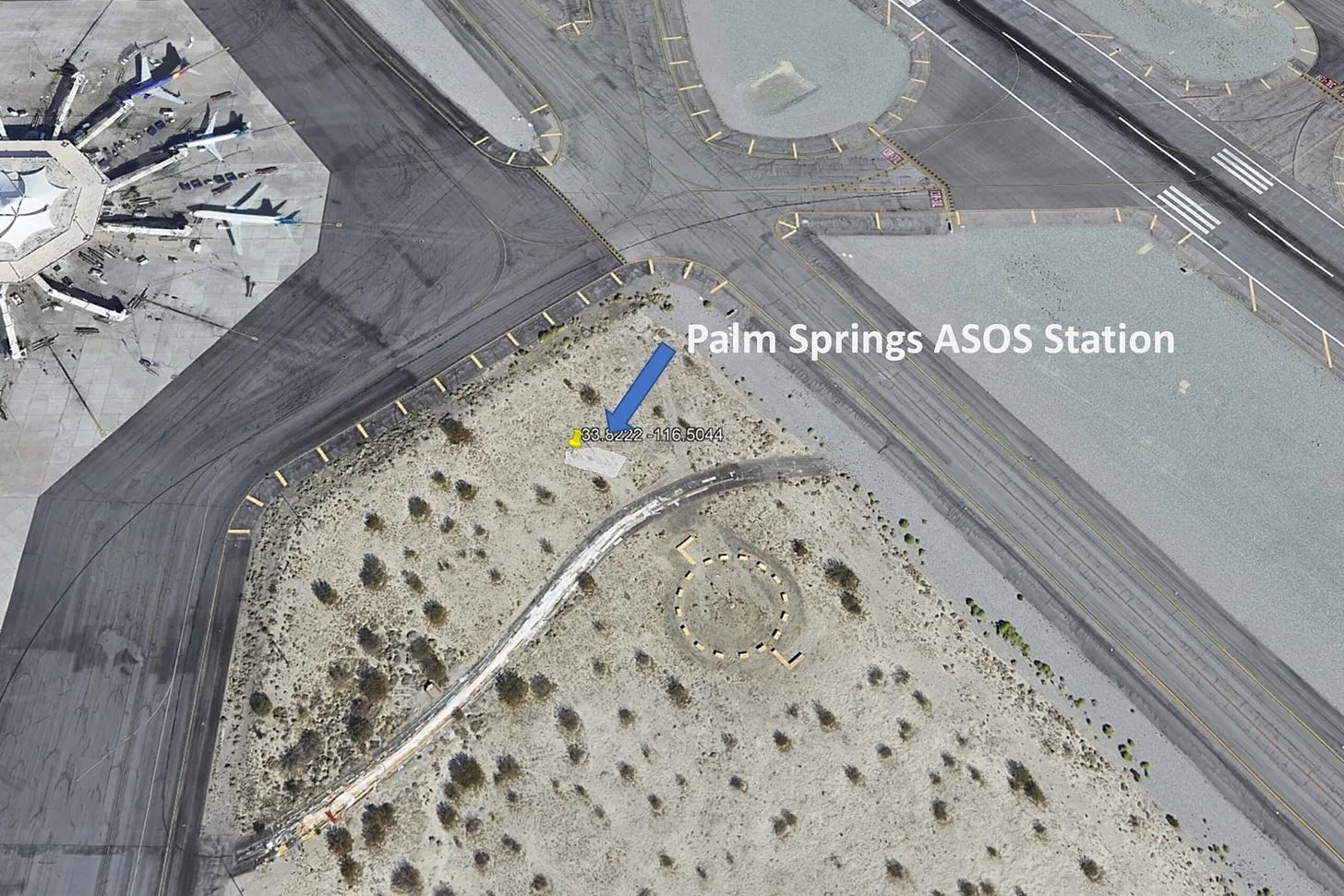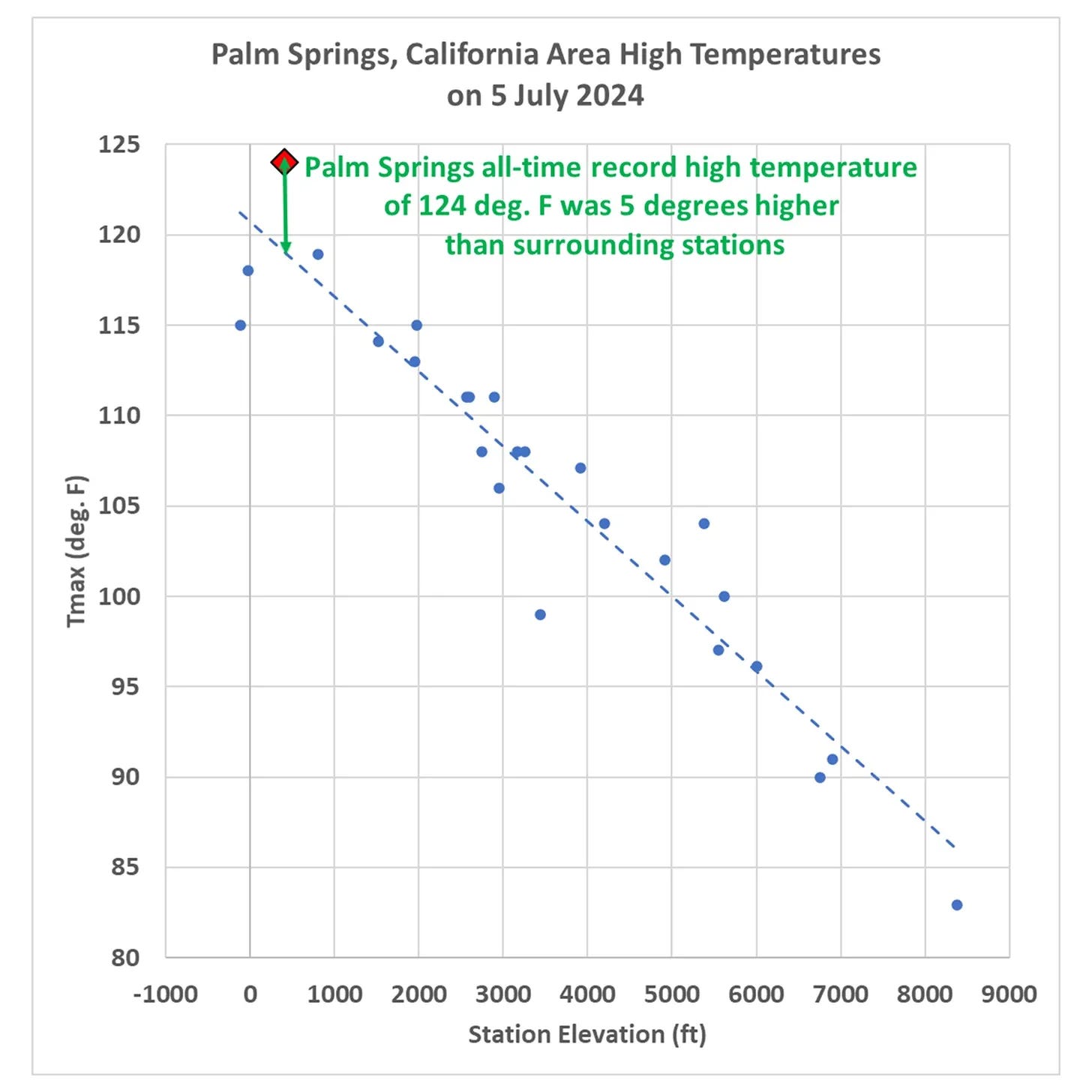Dr. Roy Spencer is an author, a climatologist, and former NASA scientist. He puts out great material. He posted an article two weeks ago that gets directly at the impact of urban heat islands on all those record temperatures that "dumb as a box of rocks” media types love to hype. Titled “Urban Legends of Climate Change: Palm Springs, California," it dispenses with the notion of one of those record temperatures. Here are a few fascinating excerpts:
I was guided by a Google search on U.S. record high temperatures for 2024, and it seems Palm Springs, California was the place to start…
Like all U.S. metropolitan areas, the population growth at Palm Springs in the last 100+ years has been rapid. Even in the last 50 years the population has nearly doubled. Natural desert surfaces have been replaced with pavement and rooftops, which reach higher temperatures than the original desert soil, and the “impervious” nature of artificial surfaces (little air content) means the heat is conducted downward, leading to long-term storage of excess heat energy and, on average, higher temperatures. More on “impervious” surfaces later….
The following Google Earth image shows the current location of the official ASOS (Automated Surface Observing System) site at the Palm Springs Airport, which recorded an all-time record high temperature of 124 deg. F on July 5 of this year.
What is somewhat amusing is that ASOS meteorological instrument siting guidance favors natural surfaces for placement, but since most of these weather stations are at airports (and since they primarily support aviation weather needs, not climate monitoring needs), the “natural” location is usually right next to runways, aircraft, and paved roads…
It only makes sense that people want to know the temperature where they live, and most of the U.S. population resides in urban or suburban locations. Yet, the temperatures they experience are, probably without exception, higher than before people moved there and started building roads, buildings, and airports.
But what is misleading for those following the global warming narrative is that record high temperatures reported at these locations almost always mention climate change as a cause, yet they have no way of knowing how much urbanization has contributed to those record high temperatures. (Remember, even without global warming, high temperature records will continue to be broken as urbanization increases).
As mentioned above, on July 5, 2024 Palm Springs broke its all-time high temperature record, reaching 124 deg. F. There are 26 other daily GHCN stations within 40 miles of Palm Springs, all with varying levels of urbanization, but even more importantly, at very different elevations. If we plot the high temperatures reported for July 5 at those stations as a function of station elevation, we see that Palm Springs is an “outlier”, 5 degrees warmer than would be expected based upon its elevation-corrected expected temperature (the dashed regression line):
Now, keep in mind that many (if not most) of those 26 surrounding stations have their own levels of urbanization, making them hotter than they would be in the absence of pavement and roofs. So, that 5 deg. F excess is likely an underestimate of how much urban warming contributed to the Palm Springs record high temperature. Palm Springs was incorporated in 1938, and most population growth there has been since World War II…
Clearly, Palm Springs has had spurious warming influence from the airport and surrounding urbanization which did not exist 100 years ago.
Just for fun, I decided to see where the nearest major weather station was to me and, sure enough, it was located at the Wilkes-Barre/Scranton Airport. The red dot shows the location next to the air control tower, amidst acres and acres of blacktop, vegetatively denuded land, and buildings, including two major four-lane highways, the airport, and a gigantic Amazon distribution center. And, there is more development still taking place. Indeed, I was involved in another major warehouse project that is approved for location at the lower edge of the photo.
The urban heat island effect is, obviously, very real.
#ClimateChange #UrbanHeatIslands #PalmSprings #Weather #Temperatures #Scranton








Urban heat islands are a big deal,and something we should devote more resources to mitigating. They don't explain ocean temperatures however!
An excellent article. The critical importance of site location has been known in atmospheric research circles for at least 50 years. I recall a project being conducted by some of my colleagues at Environment Canada in Toronto back in the early '70s, where they were trying to find some long term temperature info at sites where the data weren't compromised by nearby local effects such as runways, expressways, etc. A lot of sites were rejected as many were located at or near airports.